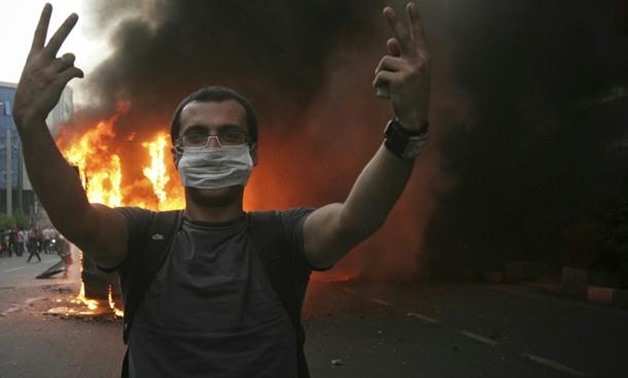CAIRO – 1 January 2018: It’s hard to expect the upcoming developments and future scenarios of the ongoing protests in Iran that began on Thursday in Mashhad, Tehran and other urban cities across the Persian country.
The ongoing demonstrations against the Iranian government differ from the “Green Movement” events that took place in 2009. The mainly common feature between the two events is the suppression of protesters by the Iranian authorities.
Iran, as a non-democratic country, has two mainstreams. The first is fundamentalist, which takes the reins of the state’s politics, powers, economy and security. The second stream is less extreme, but is not a real reformist, because it does not seek to reform the incumbent regime through major procedures in favor of the country; instead, it seeks minor reforms.

Photo 4: Supporters of the Iranian opposition demonstrate with a poster of Iran's President Mahmud Ahmadinejad (R) and a caricature of Supreme leader Ayatollah Ali Khamenei (C) on December 28, 2009 in Paris. /AFP Photo
Egypt Today sheds light on key similarities and differences between the Iranian protests in 2009 and the current demonstrations that began on December 28, 2017.
The Green Movement Protests in 2009
After the 2009 Iranian presidential election, hundreds of Iranians took to the streets calling for the removal of former President Mahmoud Ahmadinejad from office. It was named after the color green, which was the symbol of Mir Hossein Mousavi’s campaign. Mousavi, who was running in the presidential election against Ahmadinejad, and politician Mehdi Karroubi led the protests and were recognized as the Green Movement protests’ spiritual leaders.
The 2009 protests were the biggest event in Iran’s modern history since the Islamic Revolution took place in 1979, resulting in the overthrow of Mohammad Reza Shah Pahlavi. Shah Pahlavi was granted asylum by late Egyptian President Anwar Sadat, and he died in Egypt in 1980.
After declaring the victory of Ahmadinejad in the 2009 election, supporters of Mousavi protested against the results and claimed Interior Minister Sadegh Mahsouli, an ally of Ahmadinejad, had interfered and forged the election’s results to keep Ahmadinejad in power.
The Iranian police and Revolutionary Guard forces suppressed the protesters, and at least 110 people were killed, although the regime claimed only 33 were killed, including 16 members of the Basij forces (one of the five forces of the Revolutionary Guards forces) during the clashes between the protesters and the security forces, according to media reports.

Demonstrators attend a protest in support of defeated Iranian presidential candidate Mirhossein Mousavi in Vienna June 16, 2009- Reuters
The Iranian authorities succeeded to suppress the protests after approximately nine months of demonstrations and chaos using the security’s forces fiercely.
On the other side, Ahmadinejad’s supporters organized protests against the Green Movement’s supporters and chanted against the so-called foreign interference in Iran’s domestic affairs by the U.S. and western countries. The key mottos were “Death to Israel!” and “Death to the U.S.!”
The Hunger Protests in 2017
Unlike the Green Movement’s protests, the ongoing protests are against corruption and focus more on citizens’ difficult financial circumstances.
For the fifth day in a row, the Iranians found themselves standing alone in the face of a corrupt and oppressive regime. The regime has done everything it could to stop the demonstrations. Ten protesters have already been killed after clashes broke out with security forces.
Protesters have chanted, "Death to the dictator!”, “We do not want an Islamic republic!”, “Death to Khamenei!” and “Death to Hezbollah!”
Iran’s incumbent President Hassan Rouhani, who won his second presidential term in May, promised of reviving the economy following the 2015 nuclear deal with the U.S. and five other countries, which eased the sanctions on Iran in exchange for curbing nuclear activities.

Demonstrators protest against Iranian President Hassan Rouhani near the United Nations headquarters- AFP
It was a deal that the Obama administration considered as a victory for diplomatic efforts. Rouhani also took this deal as a breakthrough for economic recovery after decades of sanctions, while U.S. President Donald Trump threatened to rip up the deal two months ago due to its “flaws” and to impose further sanctions on Iran’s Islamic Revolutionary Guard as a backer of terrorist groups in the region, in reference to Hamas and Hezbollah.
What provoked the public the most was imposing those painful economic reforms, while the Iranian regime pours billions of dollars to fund the terrorist organizations in the regions, Hamas in Palestine, Hezbollah in Lebanon and Houthis in Yemen, and to fund its proxy wars in multiple countries.
The Iranian government met the protesters’ demands with violence, arresting dozens of citizens, killing two individuals, threatening those in the streets, and demanding they end the demonstrations and return home.
Anticipated scenarios
Jordanian politician Mohamed Barhouma in his analysis in London-based Al-Hayat newspaper expected only three scenarios for the ongoing protests in Iran.
First: Iranian authorities, once again, successfully crack down on the protests, exactly like what happened in 2009.
Iranians hold portraits of the Islamic republic’s supreme leader, Ayatollah Ali Khamenei, and anti-Israel placards during a protest in solidarity with the Palestinians of Gaza in Tehran on November 16, 2012-AFP
Second: Demonstrations expand to other cities, and the ceiling of the protesters’ demands gets higher, which may seek serious political reforms.
Third: Rouhani meets some of the demands, while the security forces keep suppressing and containing the protests in order not to increase.




Comments
Leave a Comment